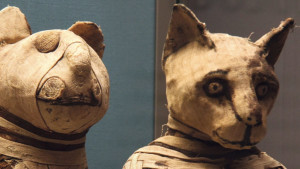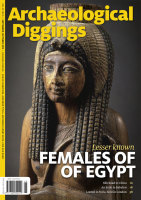The Hippocratic writings begin with the “Hippocratic Oath,” the first words of which are, “I swear by Apollo,” a reference to a god of the ancient world who has few, if any, adherents in the modern realm.
Along these lines, it is clear that many of the practices advocated by Hippocrates are also antiquated; even, in some cases, dangerous to patients. For instance, when dealing with head pain, he feels free to counsel thus: “When a person is pained in the back part of the head, he is benefitted by having the straight vein in the forehead opened,” a reference to the discredited practice of bloodletting. In turn, this practice is based on the larger theory that postulated such factors as the balanced flow of “humours” in the body being instrumental in good overall health. Concerning the flow of humours and their consequent effect on health, including how their imbalance may be cured, in the Hippocratic Writings the author says:
When veins precede, and there are influxes of black bile and of acrid humours, and the veins being pinched and dried become distended, and getting inflamed attract the humours running into parts . . . such persons are to be bled at the commencement, while all the peccant vapours and humours are buoyant, for then the cases more easily admit of a cure. (74, 75)
Thus, such techniques as alleviating liquid “humours” by bleeding the patient, a method quite absent from modern medicine, were at the forefront of Hippocrates’ ancient practices.
Nonetheless, despite the vast changes in medical science and practice in the intervening millennia, much of what Hippocrates says is surprisingly relevant to today, even admirable. These pertinent and noble aspects of Hippocratic thought deal primarily with his overall approach to medicine, his ethical values and his methods for gaining truth, much of which has resonance with the contemporary field of medical science. In this regard, five general themes are noted, specifically: (1) the overall purpose of medicine (2) the proper focus of medicine (3) the correct method for finding truth (4) the fundamental guide in the search for truth, and (5) the core ethical values for those who practice the art. These themes are closely aligned and sometimes overlap; still, they each have unique aspects that add to the overall picture. Further, as Hippocrates develops these five themes in his writings, his relevance for modernity breaks through, and this occurs despite the otherwise unappealing procedures he employs at times. In essence, as one encounters Hippocrates the textual pendulum swings between two worlds, contemporary and antiquated—indeed, between principled ideals and cringe-worthy practices.
The first of the five general themes—the overall purpose of medicine—may seem at first thought to be fairly obvious, specifically, to cure the patient. Nevertheless, upon reflection it is apparent that other goals can take the place of this primary target. For instance, the attempt to gain money and/or glory can quickly short circuit the proper objective, and Hippocrates addressed this issue. For example, in the following excerpt from the Hippocratic Writings, he clearly lays out the primary objective (curing the patient) as well as one possible inappropriate alternate purpose:
The prime objective of the physician in the whole art of medicine should be to cure that which is diseased; and if this can be accomplished in various ways, the least troublesome should be selected; for this is more becoming a good man, and one well skilled in the art, who does not covet popular coin or base alloy. (248, 249)
Clearly, in the above text he outlines the chief objective, curing the patient, as well as the wholly inappropriate aspiration of those who “covet” financial gain. Further, in the same book he elsewhere chastises those who practice medicine for self-aggrandizement. For example, after applying a short-term but otherwise ineffective cure, an unethical physician
. . . glories in his performance, and the patient who has been bandaged is well pleased, but speedily the patient complains of the encumbrance of the bandage, and the physician is satisfied, because he has had an opportunity of showing his skill . . . .” (211, 212).
In addition to the pursuit of money and glory mentioned by Hippocrates, one can also envision flawed objectives in the medical arts from modernity such as the horrors visited on their victims by the Nazi experimenters. As a result, it becomes quite obvious that adhering to the central purpose of medicine is the anchor that holds the mercy ship from going adrift; and Hippocrates is an important voice in this regard, even to today.
Closely tied to this theme, but nonetheless having important nuances of its own, is the second general theme identified as the proper focus of medicine, which is, simply put, the patient. Importantly, this focus necessarily involves an in-depth awareness of the particular state of affairs with the specific patient being treated. Along these lines, the Hippocratic Writings indicate that a proper judgment of a patient’s needs can only be formed by paying special attention to:
. . . the peculiar nature of each individual . . . to the patient’s habits, regimen, and pursuits;—to his conversation, manners, taciturnity, thoughts, sleep, or absence of sleep, and sometimes his dreams, what and when they occur;—to his picking and scratching;—to his tears;—to the alvine discharges, urine, sputa, and vomitings; and to the changes of diseases from the one into the other;—to deposits, whether of a deadly or critical character;—to the sweat, coldness, rigor, ough, sneezing, hiccup, respiration, eructation, flatulence, whether passed silently or with noise;—to haemorrhages and haemorrhoids;—from these, and their consequences, we must form our judgments. (102)
From an examination of this list, it becomes clear that the practitioner of the medical arts must be thoroughly focused on the patient; indeed, it is hard to imagine how the requisite knowledge outlined in the above list could be obtained without thoughtful and time-consuming communication. Along these lines, the author frequently encourages the practitioner to simply ask the patient. For instance, he says,
“And this is the sign that the patient has been well treated and properly bandaged: if you ask him if the arm feels tight, and he says it does, but moderately so, and especially about the fractures; and this reply he should make all along, if the bandage is properly applied” (160).
In essence, though the doctor is to be well learned by personal study outside the exam room, the primary focus of the doctor when dealing with a specific patient is that specific patient at hand, and this necessarily involves time and effective discourse; and here, again, we see the relevance of Hippocrates to the contemporary scene.
Moving ahead, Hippocrates is an empiricist who has little patience for various hypotheses which lack support via adequate investigation, and in this regard we see the third of the five general themes: the correct method for finding truth. As an example, after discoursing in the Hippocratic Writings on what he calls an “empty hypothesis,” he goes on to lament that in regard to this hypothesis “there is nothing which can be referred to in order to discover the truth” [emphasis added].
Regarding the need to “discover” the truth as opposed to relying on a “hypothesis,” he indicates that the cardinal beliefs and practices of medical science should be founded on a method “by which many and elegant discoveries have been made, during a length of time, and others will yet be found out, if a person possessed of the proper ability, and knowing these discoveries which have been made, should proceed from them to prosecute his investigations.” Thus, medical science was to be founded on “investigations” which discover the truth. Moreover, these discoveries should be the basis from which others can “proceed” to find still new breakthroughs. In effect, in Hippocrates’ mind the whole system is to be one of empirical observation whose fruits accumulate over time, and in like manner, this process is the core of the modern-day sphere of science at large, including the medical arts. Thus, again, we see an ancient genius with contemporary resonance; indeed, given his prominent place in the western canon it is quite likely that he helped to establish the empirical process as the proper methodology in the search for truth.
In addition, and noticeably related to the prior theme but nonetheless requiring specific elaboration, is the fourth theme, the fundamental guide in the search for truth. Here Hippocrates again shows his perceptive insight as he opposes practices that are hard to fathom but were nevertheless current in his day. What then was his guide for determining truth? Succinctly put, nature, or, stated with more detail, the natural purpose and function of the specific organ or body part needing attention. He says:
The presentation of the injured part to the physician, the extension, the arrangement, and so forth, are to be regulated according to nature. What is nature in these operations is to be determined by the accomplishment of the object, which we have in view, and for this purpose we must look to the part in the state of rest, in its middle state, and to habit. (153)
This theme may seem an obvious requirement to the modern reader, but in the Hippocratic Writings, the author relates a strange and even disturbing case in which a physician bound a patient’s arm in the position “as the archers do” as a means of healing an injury (156). Hippocrates responds to this alarming, and painful, occurrence by stating that “these mistakes, the physician, conceited in his knowledge, would probably not have committed if he had allowed the patient himself to present his arm,” implying by this remark that the natural function and less painful repose of the arm could be demonstrated by the patient him or herself. Further, he says, that “many mistakes and marks of ignorance are committed, regarding the natural construction of the arm.” In effect, nature, or in other words, “the natural construction” of the body is to be the guide to those who practice the healing arts.
As a further elaboration of this fourth theme, Hippocrates counsels that the healer is to pay particular attention to the pain experienced by the patient in his search for proper methodology. In effect, the pain a patient experiences can be a clue to the fact that the natural function is not being respected. Along these lines, the Hippocratic Writings make note of the work of a mistaken physician when it says:
But another physician putting the arm into the state of supination, gives orders to extend the arm thus, and bandages it in this position, reckoning it the one according to nature . . . But, indeed, if the arm be kept stretched in a supine position, it will become very painful, and this fact any one may ascertain by extending his own arm in this attitude. (158)
Thus, the pain experienced by the patient can be a guide to the natural function of the body, and the physician is to elicit its counsel.
Finally, the fifth theme is the one that binds all the others together, specifically, the core ethical values for those who practice the art. Hippocrates repeatedly counsels his readers on the proper ethical practices for those involved in medicine; indeed, the very Hippocratic Oath itself is essentially a pledge to practice medicine in an ethical way. At the very heart of this oath as contained in the Hippocratic Writings is the noble sentiment that reads, “I will follow that system of regimen which, according to my ability and judgment, I consider for the benefit of my patients, and abstain from whatever is deleterious and mischievous.” In essence, the Hippocratic physician makes a pledge, which is an ethically charged act in itself, to work for the “benefit” of the patient and to avoid “deleterious and mischievous” behaviour. Further, the oath inveighs against such practices as euthanasia, abortion, seduction, breaking confidence and so forth. The similarity of these various issues to those of the modern world goes without saying; indeed, a person may be inclined to note that the more things change the more they remain the same. In any case, the key point for our purposes in this fifth theme is simply to make note of the overall ethical approach to medicine, or, in other words, the fact that medicine is to have a moral foundation. Indeed, the oath taker says, “With purity and with holiness I will pass my life and practice my art.”
But the emphasis on ethics does not stop with the oath; throughout the Hippocratic Writings injunctions are commonly given against those who would seek to “astonish the mob” as well as against those described as “charlatans.”Indeed, the proper practice of the medical arts is more becoming a good man, and one who is skilled in the art, who does not covet popular coin or base alloy,” and certainly the “conceited” and “the physician who glories in his performance” are the bane of the medical field. Thus, proper physician conduct is crucial in the Hippocratic world view.
In summary, the Hippocratic Writings have many antiquated–even dangerous–practices that are out of place in the modern world; still, much of the mental framework of this ancient text resonates with the contemporary scene. The emphasis on a patient-centred approach in which the healing of the sufferer’s ailments is the primary purpose of the medical arts is as important today as ever. Further, the empirically-based search for truth through an accurate study of nature and the ethically-based approach to the healing arts also find a home in modernity. In point of fact, the following quote from the Hippocratic Writings ties together many of these strands, including the patient-centred focus, the need for accurate knowledge, and the avoidance of harm to the patient:
The physician must be able to tell the antecedents, know the present, and foretell the future–must mediate these things, and have two special objects in view with regard to disease, namely, to do good or to do no harm. The art consists in three things–the disease, the patient, and the physician. The physician is the servant of the art, and the patient must combat the disease along with the physician. (96, 97)
With words such as these, which many current healers could echo, we see a truly modern mind in the ancient world.







